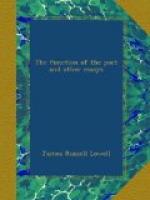LONGFELLOW
THE COURTSHIP OF MILES STANDISH
The introduction and acclimatization of the hexameter upon English soil has been an affair of more than two centuries. The attempt was first systematically made during the reign of Elizabeth, but the metre remained a feeble exotic that scarcely burgeoned under glass. Gabriel Harvey,—a kind of Don Adriano de Armado,—whose chief claim to remembrance is, that he was the friend of Spenser, boasts that he was the first to whom the notion of transplantation occurred. In his “Foure Letters” (1592) he says, “If I never deserve anye better remembraunce, let mee rather be Epitaphed, the Inventour of the English Hexameter, whome learned M. Stanihurst imitated in his Virgill, and excellent Sir Phillip Sidney disdained not to follow in his Arcadia and elsewhere.” This claim of invention, however, seems to have been an afterthought with Harvey, for, in the letters which passed between him and Spenser in 1579, he speaks of himself more modestly as only a collaborator with Sidney and others in the good work. The Earl of Surrey is said to have been the first who wrote thus in English. The most successful person, however, was William Webb, who translated two of Virgil’s Eclogues with a good deal of spirit and harmony. Ascham, in his “Schoolmaster” (1570), had already suggested the adoption of the ancient hexameter by English poets; but Ascham (as afterwards Puttenham in his “Art of Poesie”) thought the number of monosyllabic words in English an insuperable objection to verses in which there was a large proportion of dactyls, and recommended, therefore, that a trial should be made with iambics. Spenser, at Harvey’s instance, seems to have tried his hand at the new kind of verse. He says:




